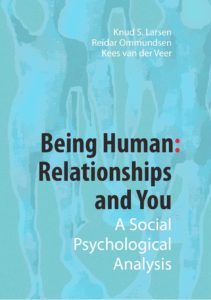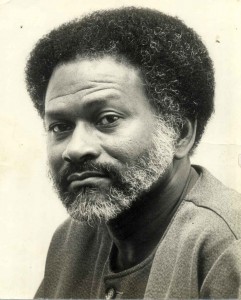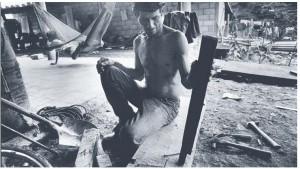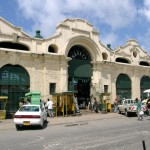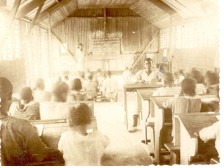Being Human: Attraction And Relationships ~ The Journey From Initial Attachments To Romantic Love
December 2018: Being Human. Relationships and You will be published completely online soon: Being Human – Contents
Many years ago two boys were walking home from school. They were seven years old, lived in the same neighborhood, but went to different grade schools. Although living close to each other they had not met before running into each other on this day on the road leading up the hill to their neighborhood. Both seemed quite determined to assert themselves that day, and soon they began pushing each other that gradually turned to wrestling, and attempts to dominate. After what seemed hours, the two little boys were still rolling down the surrounding hills as the sun was going down. Neither succeeded in achieving victory that day. In fact, they never again exchanged blows but became the best of friends. Today it is more than 50 years later, and their friendship has endured time and distance. Friendship is like a rusty coin; all you need to do is polish it at times!
In this essay we shall examine the research on attachment, attraction and relationships. The intrinsic interest in these fields by most people is shared by social psychologists, and attachment, attraction, and love relationships constitute one of the most prolific areas of investigation in social psychology. The early attachment theory advanced by Bowlby (1982) emphasized the importance of the field when he suggested that our attachments to parents to a large extent shape all succeeding relationships in the future. Other research focus on exchange and communal relationships and point to the different ways we have of relating to each other. The importance of relationships cannot be overemphasized since we as humans have a fundamental need to belong. Relationships also contribute to the social self as discussed in the book, and effects social cognition discussed in the same (see: at the end of this article). The variables that determine attraction may be understood theoretically as functions of a reward perspective.
The importance of relationships is demonstrated by findings that show that among all age groups relationships are considered essential to happiness (Berscheid, 1985; Berscheid & Reis, 1998). The absence of close relationships makes the individual feel worthless, powerless, and alienated (Baumeister & Leary, 1995; Stroebe & Stroebe, 1996). Our very humanity is defined by our relationships (Bersheid & Regan, 2005).
1. Attachment: The start to relationships
This chapter is about the development of attachment, intimate relationships between adults, and the road leading toward love relationships. No greater love has a person than giving his life for another. This idea from the Bible brings to mind the passion of deep commitment and the willingness to sacrifice, even in the ultimate sense. This willingness to sacrifice is one manifestation of love, but as we all know there is much more to relationships and love.
The research described in the following pages concerns early attachment, and attraction and love between adults. These relationships may be institutionalized by marriage, or (registered) partnership, or take some other form (living-apart-together) in relationships. Since the vast majority of romantic relationships exist between heterosexual partners we describe the journey from attraction to romantic relationship from this perspective. There is little research so there is no way to know, however, there is no convincing reason to assume that this journey is completely different for homosexuals.
Most people will experience the delirious feelings of infatuation and love sometime in their lives. What is love? How can we achieve love? And how can we build these feelings into lasting relationships? Are there ways we can improve our chances for satisfying long-lasting and happy relationships? This chapter will show that there are behaviors to avoid, but that we can also contribute much to lasting attachments. Long-lasting romance depends on positive illusions and bringing novelty and renewal to our intimate relationships.
Wan Bon – Wan Sranan – Wan Pipel: Robin ‘Dobru’ Raveles 1953-1983
Op 2 december 2002 maakte ik mijn opwachting bij Yvonne Raveles-Resida, aan de Van Rooseveltkade 34 in Paramaribo, om met haar te bespreken of in januari 2003 aan de biografie kon worden begonnen. Op 8 januari – een voor mij belangrijke dag – zou ik een aanvang maken met het doorspitten van de persoonlijke archieven van Robin Raveles. De trap naar boven leidde naar zijn studeerkamer aan de voorzijde van het huis met een balkon uitkijkend op de Nederlandse ambassade. De hoeveelheid verzamelde kranten, epistels, paperassen die uit de dozen te voorschijn kwam, zag er overweldigend uit. Zittend aan Dobru’s schrijftafel bestudeerde ik dag na dag de documenten. Zou het lukken om in de komende twee maanden van mijn verblijf in Suriname een goede eerste screening te maken? Selectie van de meest relevante en interessante stukken zou een van de grootste problemen worden.
Welke criteria zou je moeten hanteren om tot een uiteindelijke selectie te komen? Eddy Bruma, oud-voorzitter van de PNR, had gelijk toen hij zei dat Dobru de beste verzamelaar is geweest die hij had gekend. In de studeerkamer bevonden zich, naast zijn eigen publicaties, ook rijen boeken, gesigneerd door collega-schrijvers uit het Caraïbisch gebied en Latijns-Amerika onder wie Edward Kamau Brathwaite, Ernesto Cardenal, Jan Carew, Martin Carter, Selwyn Cudjoe, Nicolás Guillén, Earl Lovelace, George Lamming, Andrew Salkey en A.J. Seymour. Oude anthologieën maakten ook deel uit van de collectie, onder andere Caribbean Voices. An Anthology of West Indian Poetry (1968) en A Treasury of Guyanese Poetry (1980). Ook de Surinaamse schrijvers Trefossa, Slory, Shrinivási, Ooft, Doelwijt, Verlooghen en vele anderen waren goed vertegenwoordigd. Voorts waren er talloze losse vellen met aan hem toegestuurde gedichten en een groot aantal boeken aan Dobru opgedragen van auteurs die hij tot schrijven had aangemoedigd.
El Salvador en transición
El acuerdo de paz firmado el 16 de enero de 1992 entre el gobierno y el movimiento rebelde FMLN puso fin a más de diez años de guerra civil en El Salvador. En este capítulo trataré los antecedentes de esa guerra y el desarrollo y el proceso que llevaron al acuerdo de paz. El énfasis radica en los cambios entre el estado, los partidos políticos y las organizaciones de la sociedad civil. De esta manera surge una imagen del contexto social en que nacieron las organizaciones de ayuda para el desarrollo y del espacio donde estas organizaciones intervinieron. Para dar una imagen global del contexto histórico de la guerra civil, me adentraré primero en algunos importantes desarrollos políticos y económicos que tuvieron lugar entre 1870 y 1970. Trataré después a los principales actors en los decenios anteriores a la guerra civil. Estos eran, entre otros, los (nuevos) partidos políticos, los militares, las organizaciones paramilitares, la iglesia y los movimientos revolucionarios. Seguirá a continuación el tema de la guerra civil, en el que se prestará atención al papel desarrollado por el FMLN, los partidos políticos, el gobierno salvadoreño y los Estados Unidos. Para terminar, se tratará el acuerdo de paz. Esbozo allí los cambios principales que tuvieron lugar en base a la llamada ‘triple transición’ en El Salvador.
Una historia de exclusión
Para Torres Rivas y González Suárez (1994:12), la guerra civil fue el resultado de un largo período de exclusión social, económica y política a la que fueron sometidos grandes sectores de la población. Este proceso tuvo profundas raíces históricas y llevó en los años sesenta y setenta a la polarización y al agravamiento de la crisis en la sociedad salvadoreña. La crisis social que surgió en estos años no puede explicarse sólamente como el resultado de la influencia de los Estados Unidos o de la oposición de la poderosa oligarquía agraria a las reformas (Carrière y Karlen, 1996:368). Hubo una combinación de factores internos y externos que en los años anteriores a la guerra impidió una modernización a fondo de la política, la economía y la sociedad. La mayoría de los análisis de la guerra civil salvadoreña comienzan en la segunda mitad del siglo pasado. Este fue el período en el que se desarrollaron el cultivo y la exportación de café a gran escala. El café tuvo una influencia definitiva en las relaciones sociales salvadoreñas en gran parte de ese siglo. El cultivo y la exportación de este producto fueron la reacción ante la disminución de la demanda internacional de indigo, un colorante azul oscuro de textiles que constituía hasta entonces el principal producto de exportación de El Salvador. Las mejores condiciones para el cultivo del café se dan en suelos situados entre los 500 y los 1.500 metros sobre el nivel del mar. Una gran parte de los suelos adecuados para el cultivo del café eran propiedad comunal, entre otros de pueblos indígenas. El gobierno dirigido (desde 1871) por los liberales era partidario de la comercialización en el usufructo de los suelos y abolió la propiedad comunal de la tierra en las reformas de 1881 y 1882. Un número relativamente pequeño de familias (entre ellas las dedicadas antes al cultivo del indigo) compró grandes extensiones de tierra, dominando rápidamente la producción y el comercio del café. Read more
From The Web – University of Oxford – Podcasts from The School of Anthropology & Museum Ethnography
Podcasts from the School of Anthropology and Museum Ethnography. The School is renowned for its contributions to anthropological theory, its commitment to long-term ethnographic fieldwork, and its association with the Pitt Rivers Museum and the anthropology of visual and material culture. Home to over forty academic staff, over a hundred doctoral students, twelve Master’s programmes, and two undergraduate degrees (Human Sciences; Archaeology and Anthropology), Oxford anthropology is one of the world’s largest and most vibrant centres for teaching and research in the discipline. It came top of the Power (research excellence + volume) rankings for anthropology in the UK in RAE 2008.
See: http://podcasts.ox.ac.uk/series/anthropology
Efficacy of Tourism as a Tool for Local Community Development: A Case Study of Mombassa, Kenya
Having unique indigenous cultures, nature-based attractions, beautiful landscapes, and pleasant weather conditions, local communities in Africa, and other Third World countries, are increasingly being promoted and marketed in major tourist generating countries, particularly in Europe and North America, as offering immense touristic and recreational opportunities. Particularly, indigenous communities in the Third World are perceived as providing abundant opportunities for rich tourists from the North who have got the financial resources to spend in adventure and exotic recreational activities. As a consequence, an increasing number of international tourists are travelling to different tourist destinations in Africa and other less developed regions of the world. In 2001 for instance, over 28 million international tourists, mainly from Europe and North America, travelled to different destinations in Africa. It is further estimated that with the current international growth rate of the tourism industry, over 77 million international tourists will visit Africa by the year 2020 (WTO 2004).
Neo-classical economists and development experts contend that unlike factor driven technology based development, local communities in Africa and other parts of the Third World have a comparative advantage in the development of tourism and other non-technology based economic sectors. The development of tourism amongst local communities is, therefore, perceived as fitting quite well with the ‘natural process of development based on comparative advantage’ (Brohman 1996). This argument is based on the premise that local communities, particularly in Africa, should mainly specialise in primary exports, including tourism, where they have comparative advantage rather than depending on technology based economic sectors that do not conform with the principles of comparative advantage in the global market demand.
When Congo Wants To Go To School – Educational Organisation In The Belgian Congo (1908-1958)
Contexts
The first part of this study will concentrate on the wider environment within which daily practice of colonial education is situated. It progresses in three stages in accordance with the aim of the research. Three chapters correspond with these three stages. The general, macro-institutional context of the phenomenon of colonial education is considered in the first chapter. This includes a discussion of the organisational development and politico-strategic factors that influenced this phenomenon. The development of the educational structures is indicated from the angle of the interaction between state intervention and the Catholic initiative. Within that framework the major themes in the content and emphasis of colonial lesson plans are also considered, as are the opinions on these subjects. Finally, figures are given to allow an estimate of the quantitative development of education in the colony. The second chapter shifts the focus to Belgium. The preparation, training, ideas and worldview with which the missionaries left for the Belgian Congo will be considered more closely. This chapter is divided into two parts. The first part considers a number of broad social and historical factors that played a part in the formation of the missionaries’ general intellectual baggage. Mainly results of existing research are presented and discussed in this part. The second part takes a closer look at the people who are of specific interest to us, covering the preparation and training given to the Sacred Heart Missionaries in Belgium and using specific source material. In the third chapter we make the journey to the Congo together with these missionaries. A number of elements are given in a short outline that also constitute the direct context of their work. Firstly, a description is given of the creation and growth of the mission region in which they were active. Then follows the introduction of the other missionary congregations, with which the Sacred Heart Missionaries cooperated. Finally, quantitative data are brought together with regard to the development of education, both for the mission region as a whole and for the various mission posts separately. Read more
